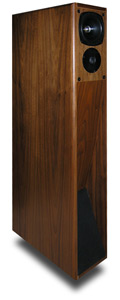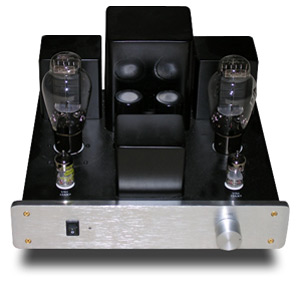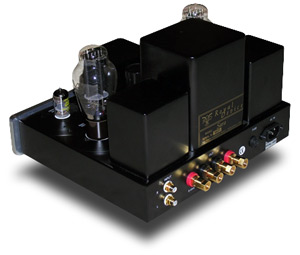![[SoundStage!]](../titles/sslogo3.gif) Home
Audio Home
Audio Equipment Review |
||||||||||||||||||||
April 2006 Royal Device Sara / RD / Erica Mk II Speaker Systemby Vade Forrester
Royal Device is an Italian company led by Roberto Delle Curti. Although Delle Curti's first products were speakers, his research indicated that interactions among the amplifier, the speaker cables, and the speakers themselves played a much bigger role than we normally realize, so he now prefers to sell optimized systems rather than speakers only. In keeping with the systems approach, I received three Royal Device products for review and used them together, not as individual components. The entire system costs $7495 USD and includes loudspeakers, a stereo amplifier, and speaker cables. My mouth watered when I learned I’d be reviewing Italian speakers, which are renowned for their gorgeous cabinetry. The Erica Mk IIs were veneered with genuine walnut that was perhaps not of Sonus Faber quality, but still attractive. The Erica II is a floorstanding speaker with a 5 1/4" purpose-built paper-cone midrange/woofer and a 3/4" SEAS soft-dome tweeter. The midrange/woofer is run full range, while the tweeter has a 24dB-per-octave phase-coherent filter to mesh with the natural decay of the woofer. A rear-loaded horn enclosure augments the bass from the smallish midrange/woofer. The overall enclosure is quite small for a horn: 39"H x 7"W x 16"D and weighing 44 pounds. Biwire terminals in the back let you connect separate cables to the midrange/woofer and tweeter, an essential part of Delle Curti’s design. The Erica Mk II’s specifications indicate a response of 32Hz-20kHz; this is amazingly low bass extension for a 5 1/4" woofer, even with horn loading. While for other models of Royal Device speakers the soft-dome tweeter is loaded with a horn, with the Erica II the tweeter radiates directly. The Ericas II’s claimed sensitivity is 93.5dB using Thiele/Small parameters and 95dB weighted for room ambience. The Royal Device RD speaker cable is a biwire setup with bare stranded copper wire on both ends. The cable had a rather homemade look about it, but I suppose it’s the sound that counts. When I asked designer Delle Curti why he chose to make his cables look so plain, he replied, "I think that really it does not need to have high-cost marketed things to get good audio results." Delle Curti also felt that the additional solder connection required for spade-lug termination could degrade sound. Perhaps he’s right. However, the bare wire of the review samples was beginning to show signs of corrosion. Also part of this system is the Sara amplifier, a 10Wpc single-ended-triode stereo amp using 300B output tubes and 12AX7 tubes as the input/drivers. A Royal Device Aliante Audiocap capacitor couples the input stage to the output stage, and it is the only capacitor in the signal path. The power supply is solid state. Valve Art 300B tubes and Electro Harmonix 12AX7 tubes were included with the review sample.
The solidly made Sara is quite compact for a 300B stereo amp, measuring 12 1/2"W x 7 7/8"H x 13"D and weighing 28 pounds. The rear panel sported a pair of RCA input jacks and left- and right-channel pairs of massive binding posts, which, unlike many binding posts lacked a hole to accept bare wires. That seemed odd because the Royal Device speaker cables had bare-wire ends. The output speaker terminals were labeled "8 ohms." The Sara hit one of my hot buttons by placing the on/off switch on the front panel, where it belongs. With the volume control set to its maximum, the amp’s input sensitivity is 0.8 volts for full output. Although the amp looked like a power amp, it’s intended to be used as a single-source integrated amp. The Sara’s input impedance was a low 10k ohms, which should be a good match for most solid-state devices. However, this is lower than many tube preamps can comfortably drive. For those of us with several sources, the lack of multiple inputs would be a problem. And if you want amenities like remote volume control, a feature found on many integrated amps today, you’re out of luck. The Sara's manual sternly warns that "300B TUBE BIAS REGULATION must be done by qualified personnel ONLY." However, designer Delle Curti said that you can replace the tubes without resetting the bias if you use matched pairs of 300Bs. So why doesn’t the manual say that? Neurotic audiophile that I am, I would worry that incorrectly set bias would produce substandard sound. For a more precise setting, Royal Device dealers are equipped to set bias using test equipment, or distributor O.S. Services can set the bias at its California service department for a nominal charge. I have nothing against manually biasing output tubes, but externally accessible test points and bias pots would enable a user to make those adjustments and indulge in some tube rolling. Setting up I placed the Sara on a spiked amp stand next to my equipment rack and connected my CD player directly to the its single input. After trying Purist Audio Design Venustas and Crystal Cable Piccolo interconnects, I chose the Venustas. They had greater frequency extension at both ends of the spectrum, and a smoother response, while the Piccolo had a depression in the upper midrange and a peak in the midbass that produced a one-note-bass effect. It’s interesting that the Royal Device system’s transparency made it easy to identify the sonic characteristics of both cables. Wanting to play some LPs through the system, I connected my deHavilland Mercury preamp to the Sara. However, the tube preamp didn’t drive the Sara as well as I had hoped, lacking sufficient output to drive the speakers to my preferred volume.
I achieved the best balance between soundstaging and bass performance with the Erica IIs placed 7 1/2 feet apart, and 18 inches from the front wall (measured to the back of the cabinet). The cabinets were toed in so the axis of the drivers pointed directly at my listening position. The Erica IIs have a rather small footprint, and initially came with no stabilizing base or spikes, making them somewhat wobbly on my carpeted floor. The rounded side corners on the bottom of the cabinets further decreased lateral stability. Delle Curti told me that he hates spikes, and prefers to place the speakers on a "moquette" (carpet). Later, distributor Randy Bankert provided some spikes, which will be standard with all Erica IIs sold in the US. At first, the spiked Erica IIs seemed every bit as wobbly as the unspiked versions, but after the spikes settled into the carpet overnight, the speakers’ stability improved greatly. Bass detail and extension improved with the spikes in place, so I used them for my listening tests. The Erica IIs sounded more open and extended with their black cloth grilles removed. Most do sound better nude -- speakers, that is, not listeners. Delle Curti told me that the grille smoothed annoying and badly mixed digital recordings. Perhaps that’s correct; I didn’t try any such recordings. Another grille covered the mouth of the horn, but I left that one in place. Sound In my largish listening room (23'W x 20'D x 12'H), I had to crank the Sara’s volume control up to almost the 3:00 position to reach the volume I prefer, and I’m no headbanger. (My wife may disagree, but don’t listen to her.) If heavy metal is your preferred musical genre, this system probably won’t fill the bill. It might also be better suited to a smaller room than mine. As you might expect from a narrow speaker with rounded corners, the Erica Mk IIs are soundstaging champions. Their soundstage is huge, with individual performers located very precisely within it. There was a lot of air around each performer in a small group. The choir in the Tallis Scholars’ "Allegri: Miserere," from their CD Miserere [Gimmell 454 939-2] was spread wide across the soundstage, and the solo group was clearly located well behind the main choir.
The Royal Device system fully sustained the reputation of Italian hi-fi equipment for handling voices well. Eva Cassidy’s "Fields of Gold" from her CD Songbird [Blix Street Records G2-10045] was ravishing, with plenty of detail and nuance. Another Italian hi-fi tradition was equally well served: reproduction of stringed instruments. The Utah Symphony Orchestra’s performance of Ralph Vaughn Williams’ "Variations on a Theme by Thomas Tallis" from the CD layer of the SACD reissue of Vaughn Williams [Vanguard Classics ATM CD 1507] sounded utterly gorgeous. And any reviewer who auditions Italian equipment has to play something operatic, so I cued up Angela Gheorghiu’s exquisite performance of Puccini’s "O Mio Babbino Caro" on Puccini [EMI Classics 7243 5 57955 0 2]. Gheorghiu’s creamy-smooth soprano caressed my ears, projecting power when required, but it was always under complete control. If vocal music is an important part of your listening habit, this Royal Device system should be on your short list. The Erica Mk II's SEAS tweeter sparkled when called on to do so, but was not the slightest bit etched or piercing. I listened closely to see how the speakers behaved in the crossover region. To my ears, the upper-midrange/lower-treble region had a very slight dip in frequency response between the tweeter and the midrange/woofer, which gave the Royal Device system a laid-back presentation. When I played Jennifer Warnes’ "The Panther" from the CD layer of her SACD The Well [Cisco SCD 2034], all the high-frequency detail was there, but some of the overtones of the percussion instruments were slightly attenuated. Dynamics are responsible for much of a hi-fi’s expressiveness and excitement. The Royal Device system was slightly lacking in macrodynamics, those large swings in volume that bring life to music, although microdynamics, the smaller adjustments in volume, were handled very well. I wondered if one of the higher-powered Royal Device amplifiers would restore the missing macrodynamics. With acoustic music -- classical, jazz, or folk -- the system paints a very appealing sonic picture. The leading edges of transients were a smidgen rounded, which contributed to the impression of dynamic reticence, as well as slightly diminished detail. I was initially skeptical of the Royal Device claim for 32Hz bass, but I was pleasantly surprised to discover that there really was useful output at 32Hz in my room, although somewhat lower in amplitude than higher frequencies. However, the system could not realistically reproduce the massive low-frequency bass-drum roll on the Eije Oue/Minnesota Symphony Orchestra recording of Kabalevsky’s "Overture to Colas Breugnon," from Bolero! [Reference Recordings RR-92CD]. Such a task requires large woofers and lots of power, but it is quite spectacular when done right. However, "Way Down Deep" from Jennifer Warnes’ The Hunter [Private Music 01005-82089-2] was amazing for a 5 1/4" driver. The bass was clean, deep, and fairly well defined, although the initial impact was a bit blunted. The Royal Device system approach is certainly different in the hi-fi world, where audiophiles often relish the activity of building a system piece by piece. This collection of products takes away that fun, but also removes the chance of messing things up, at least as far as the amplifier, speaker cables, and speakers go. The value of such a system, and such an approach, will be a very personal matter. Some audiophiles enjoy constructing the means, and others enjoy the musical end. Those in both groups won't find the price of this Royal Device system to be out of line with speakers, speaker cables and amplifiers of similar sonic quality. Comparison Like the Royal Device system, my reference combo uses feedback-free SET amplifiers and speakers that augment bass with a rear horn-loaded enclosure. True, my Second ReTHM speakers ($7500 per pair) use a single full-range 8" driver rather than a separate tweeter and midrange/woofer, and my Crystal Cable Micro speaker cables ($1950 per two-meter pair) were chosen by ears (mine) rather than by electrical parameters. WBT spades on the cable ends ensure good, corrosion-free connections to the amp and speakers. My Welborne Labs 300B DRD monoblock amps ($1732 kit price), a new addition to my reference system, are rated at only 7 watts each, substantially less than the Sara, but this is more than sufficient power for my 102dB sensitive ReTHM speakers. My reference system has faster and more distinct leading-edge definition than the Royal Device system, and is considerably more dynamic. Bass does not go particularly deep; the Royal Device system went lower, but with less slam and bass detail. The Erica II’s separate tweeter seemed more extended than the ReTHMs’ full-range drivers, but not by much. The ReTHM speakers are more analytical and detailed, but they can sound with some material a little aggressive. In most ways, these two systems sounded utterly different -- the relaxed beauty of the Royal Device system versus the speed and detail of my reference rig. Oh, to have two listening rooms! Bottom line The Royal Device system’s mellow, smooth sound encouraged all-day listening sessions. It exhibited a refreshing sonic purity, along with good detail retrieval and beautiful tonality. I’ve voiced a few quibbles regarding build quality, but sonically these products delivered. If you want a system to play at fraternity-party levels and sock you in the gut with powerful bass energy, look elsewhere. It’s not hard to find worthy speakers, amplifiers, and cables in this price range. But if you want surprisingly full-range sound and a detailed soundstage from small, floorstanding speakers that are easy on the ear and eye, the Royal Device system will give you the royal treatment. ...Vade Forrester
|
||||||||||||||||||||
|
||||||||||||||||||||
![[SoundStage!]](../titles/sslogo3.gif) All
Contents All
ContentsCopyright © 2006 SoundStage! All Rights Reserved |


 Because the amp
came without a power cord, I used a Blue Marble Audio cord. The Sara was unfussy and
extremely quiet in use. Although it had pots to adjust hum level, I never felt any need to
bother with them. I just wrapped the bare-wire-ended speaker cables around the binding
posts and tightened them down, making sure the cables weren’t squished off the post
in the process. The large binding posts seemed to grip the bare cable securely, allaying
my worries that the cable might slip off. Even when I drove the amp very hard (which I
usually did), it ran quite cool -- except for the tubes, of course.
Because the amp
came without a power cord, I used a Blue Marble Audio cord. The Sara was unfussy and
extremely quiet in use. Although it had pots to adjust hum level, I never felt any need to
bother with them. I just wrapped the bare-wire-ended speaker cables around the binding
posts and tightened them down, making sure the cables weren’t squished off the post
in the process. The large binding posts seemed to grip the bare cable securely, allaying
my worries that the cable might slip off. Even when I drove the amp very hard (which I
usually did), it ran quite cool -- except for the tubes, of course.